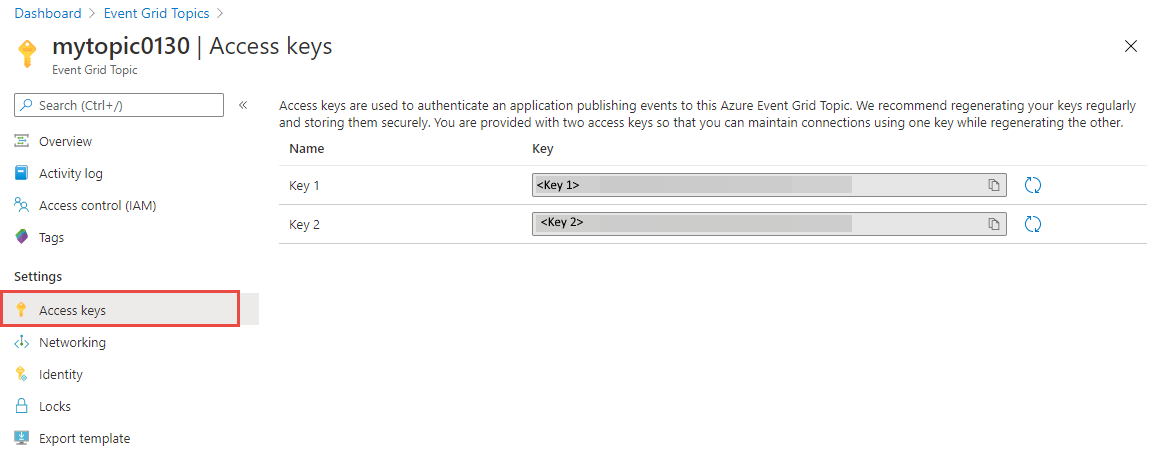Get access keys for Event Grid resources (topics or domains)
Access keys are used to authenticate an application publishing events to Azure Event Grid resources (topics and domains). We recommend regenerating your keys regularly and storing them securely. You're provided with two access keys so that you can maintain connections using one key while regenerating the other.
This article describes how to get access keys for an Event Grid resource (topic or domain) using Azure portal, PowerShell, or CLI.
Important
From August 5, 2024 to August 15, 2024, Azure Event Grid will rollout a security improvement which will increase the SAS key size from 44 to 84 characters. This change is being made to strengthen the security of your data in Event Grid resources. The change doesn't impact any application or service that currently publishes events to Event Grid with the old SAS key but it may impact only if you regenerate the SAS key of your Event Grid topics, domains, namespaces, and partner topics, after the update.
We recommend that you regenerate your SAS key on or after August 15, 2024. After regenerating the key, update any event publishing applications or services that use the old key to use the enhanced SAS key.
Azure portal
In the Azure portal, switch to Access keys tab of the Event Grid Topic or Event Grid Domain page for your topic or domain.

Azure PowerShell
Use the Get-AzEventGridTopicKey command to get access keys for topics.
Get-AzEventGridTopicKey -ResourceGroup <RESOURCE GROUP NAME> -Name <TOPIC NAME>
Use Get-AzEventGridDomainKey command to get access keys for domains.
Get-AzEventGridDomainKey -ResourceGroup <RESOURCE GROUP NAME> -Name <DOMAIN NAME>
Azure CLI
Use the az eventgrid topic key list to get access keys for topics.
az eventgrid topic key list --resource-group <RESOURCE GROUP NAME> --name <TOPIC NAME>
Use az eventgrid domain key list to get access keys for domains.
az eventgrid domain key list --resource-group <RESOURCE GROUP NAME> --name <DOMAIN NAME>
Next steps
See the following article: Authenticate publishing clients.
Pripomienky
Pripravujeme: V priebehu roka 2024 postupne zrušíme službu Problémy v službe GitHub ako mechanizmus pripomienok týkajúcich sa obsahu a nahradíme ju novým systémom pripomienok. Ďalšie informácie nájdete na stránke: https://aka.ms/ContentUserFeedback.
Odoslať a zobraziť pripomienky pre